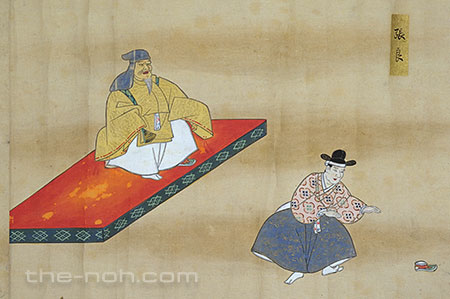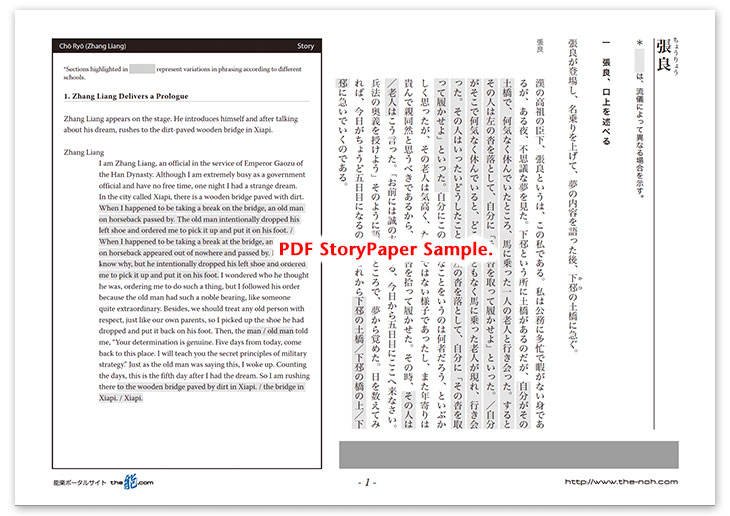
 Chō Ryō (Zhang Liang)
Chō Ryō (Zhang Liang)

![]()
Zhang Liang (?- 186 BCE, Chō Ryō in Japanese) who is serving the Han dynasty Emperor Gaozu (256 BCE- 195 BCE, born Liu Bang) has been passing his days busily attending to his duties. One day, he has a dream in which he meets a strange old man riding a horse at a dirt-paved wooden bridge in Xiapi (present-day Pizhou City in Xuzhou, Jiangsu province, China). The old man on horseback intentionally lets his shoe fall off and orders Liang to pick it up and put it back on his foot. Sensing the old man’s unusually noble demeanor, Liang assumes that the man is someone extraordinary and, following his order, puts the shoe back on his foot. Then, the old man promises to teach him the secret principles of military strategy, if he comes back to this bridge five days later. At this point, Zhang Liang wakes up.
On the fifth day, the day of the promised meeting, Zhang Liang returns to the bridge, but he arrives later than the promised time as the place is further than he expected. The old man scolds Liang for being late and angrily tells Liang that he is not worthy of being waited for and should go home now. However, the old man tells Liang that he will still give him one more chance and after promising to meet him again five days later, vanishes into thin air. Although Liang is daunted by the old man’s bad temper, he reconsiders matters and concludes that his seriousness for receiving the secrets of military strategies was being tested. Feeling much better, Liang returns home.
On the day of the next promised meeting, Zhang Liang arrives earlier at the bridge and waits for the old man. The old man appears and introduces himself as Huang Shigong (literally, “the man of yellow stone”). In order to test Zhang Liang once again, Huang Shigong intentionally drops his shoe into the river. Liang immediately jumps into the river, but the rapid current and rocks prevent him from retrieving the shoe. Just then, a giant snake appears and reaches the shoe before him. The snake attacks Zhang Liang. Remaining calm, Liang unsheathes his sword and defends himself against the snake. He succeeds in taking the shoe away from the snake, which is scared of the glare of his sword, and putting it back on to Huang Shigong’s foot. Huang Shigong praises Zhang Liang and imparts upon him the secret principles of military strategy. The giant snake reveals that it is a transformation of the Bodhisattva Guanyin (in Japanese, Kannon) and has appeared before Liang in order to test him. After promising to be his guardian deity from now on, the giant snake ascends to the sky. Huang Shigong climbs up a high mountain where he transforms himself into golden shining light and becomes a yellow boulder.
![]()
This piece is one of the Chinese stories (kara-mono) set in the city of Xiapi in ancient China. It dramatically describes the ancient legend of a famous military leader, Zhang Liang, upon whom military strategies were bestowed. Xiapi is a place rich with history; during the era depicted later in the Record of the Three Kingdoms, the city became known as the battlefield where Cao Cao and Liu Bei fought against Lu Bu. Zhang Liang, the waki character in this play, appears on the stage first and introduces himself as an officer serving Emperor Gaozu of Han (Liu Bang), however, he was not yet in the employ of Liu Bang when he lived in Xiapi. This is a typical technique used in Noh dramas, to neglect historical facts and rearrange chronological events, in order to easily introduce and impress a character to the audience.
Two Noh dramas, “Chō Ryō (Zhang Liang) ” and “Kurama Tengu (Long-nosed Goblin in Kurama)” share some elements, as the main episode of “Chō Ryō,” in which Zhang Liang receives the secret principles of military strategy from Huang Shigong is also told in “Kurama Tengu” as a play within play. In “Chō Ryō,” most Noh schools use the music of Ōbeshi, which is used as the entrance music of a long-nosed goblin when nochi-shite (Huang Shigong) enters the stage. These similarities attest to the close relationship between these two plays. Indeed, it would be interesting to compare these two pieces.
Zhang Liang (Chō Ryō in Japanese), whose name is used for the title, is waki, a secondary character, but assumes an extremely important role. In most Noh plays, waki is an onlooker, such as a monk on a pilgrimage or a court officer, who quietly sits in his seat. However, this is not the case in “Chō Ryō.” Changing his costume in the second half of the drama, Zhang Liang appears on stage gallantly, jumps into white-water rapids to pick a shoe up, and does battle against a giant snake. He performs very actively as the main role. This is a difficult, advanced part for a waki performer and therefore, this play is considered to be hiraki-mono (a piece that requires advanced level of performance for players and therefore used to present a performer’s level of maturity). A legend says that the author of this piece, Kanze Kojirō Nobumitsu, was a master waki performer, and in addition to this “Chō Ryō,” he created other dramas such as “Momijigari (Autumn Foliage Viewing)” and “Funa Benkei (Benkei Aboard a Boat ),” in which waki plays an important role.
We cannot ignore the presence of the stage prop in the play, a shoe. Usually, an observer (kōken) tosses the shoe. Although the kōken aims and tosses the shoe to a predetermined place, where the shoe actually lands changes every time the play is performed, creating variations in the movements of waki and tsure. This makes the drama even more entertaining. Some schools have the lead character (shite) wear the shoes when he appears on the stage.
STORY PAPER : Chō Ryō (Zhang Liang)
Story Paper presents noh chant stories in modern speech, with story outlines, highlights and more using Adobe PDF format, which can print out and zoom in. Print out the pages and take them with you when you see the actual noh performance.

The copyright of Story Paper is held by the Noh.com. Story Paper is for individual use only. It is prohibited by the copyright law to distribute or publish printed-out Story Paper pages without prior consent. For more information, check the credit and disclaimer pages.



 [Chō Ryō (Zhang Liang) : Story Paper PDF : 482KB
[Chō Ryō (Zhang Liang) : Story Paper PDF : 482KB